#khmer village
Explore tagged Tumblr posts
Video
youtube
Buffet Breakfast at Resort Sen Monorom, Lunch at Resort Phumi Ratanak Mo...
#youtube#mondulkiri#cambodia travel#breakfast#sen monorom resort#krong sen monorom#ratanak resort#ratanak village#khmer village#angkor cambodia
0 notes
Video
youtube
One Night at Phumi Khmer Resort: Visit Giant Bird and Elephants in Ratan...
#youtube#elephant#elephant lovers#kanseng lake#giant birds#birds statue#couple birds#phum khmer resort#khmer village resort#ratanakiri#angkor cambodia
1 note
·
View note
Text
Tonle Sap: Going Off Limits & Sleeping With Toads

View On WordPress
#Bird watching#Cambodia#Floating Village#independent travel#Khmer cuisine#Mekong#Prek Toal#Tonle Sap#Village life#Wading birds
0 notes
Text
First of all, sorry for my english writing, it's not my first language :').
I'm just thinking about something related to ATLA, an AU where the four nations and the characters are swapped. But not just that; instead of Aang, Toph will be the Avatar, and she will still be blind. She is found by the Fire Nation siblings Zuko and Azula in a volcano with her pet badgermole. I have always been looking for an AU like that, but I have never found it completely, so I decided to create my own. I know that there are already some AU blogs or fanfics with this same concept, and maybe if it's not creative at all, I want to show my own interpretation of this AU. We can share headcanons and fanfics about this subject and discuss it. I deeply want to know what people will think about this—whether my interpretation is good or bad. Anyway, let's talk about it! :) (Many aspects of this fanfic, especially regarding the villains, are inspired by the fanfic Avatar: Distorted Reality, but don't worry; I will try to ensure this is not an entirely copied work, I promise).
Some things about background and worldbuilding:
• The Air Nomads will remain the same and have the cultural inspiration from the show (Tibetan Buddhists and Bhutan). The only difference from the canon is that these Air Nomads would develop science and technology significantly, especially aerospace technology like air balloons and gliders (as shown in the episode "Northern Air Temple"). They would also be alchemists, inspired by Chinese alchemy, and develop science and medicine alongside spirituality. The Water Tribes (in this case, the Water Empire) will still have the same inspirations as the show, but with building and architecture, and marine domination and technology inspired by Srivijaya and the Khmer Empire. They will have incredibly aquatic-inspired technology and highly developed science and engineering.
Fire Nation: It is a fact that the Fire Nation is very inspired by Imperial Japan. In this universe, since they are no longer militaristic and industrialized, they will have a cultural background inspired by the Philippines, Malaysia, and Indonesia. They will also draw inspiration from Sri Lanka, as well as Aztec, Inca, and Maya cultures, making them a culture more akin to the Sun Warriors. The societal structure will be more tribal, with each archipelago of the Fire Nation being a tribe led by a high-class family represented by the Fire Lord (the equivalent of a chieftain instead of a monarch). This high-class family is a clan with a surname to differentiate them from other families. Thus, Zuko and Azula's family are nobles who rule Fenghuang Island, and their surname is "Hinoko," which means "children of fire" (a reference to the importance of firebending for the canon royal family). So, despite Zuko and Azula not being royalty, they are very respected because they come from a noble family and are the children of the chieftain of their village.
Earth Kingdom: The source of cultural inspiration for the Earth Kingdom will differ from the canon. Instead of the Chinese Dynasty and Korea, the focus will be on underrepresented Asian peoples, drawing great inspiration from the Highland peoples of Vietnam and Thailand (especially the Hmong people), the Evenki people, the Ainu people, Siberian-Mongolian nomads (Tsaatan, Tuvan, and Byart), and minority ethnic Chinese groups (Bouyei, Qiang, and Mulao). Just like the Fire Nation, they will not be very militaristic or highly structured, but they will have a decentralized society that works in a tribal and community-oriented style. Therefore, they will not have a kingdom anymore but rather fractured tribes and villages that have a strong sense of community (living near mountains, caves, or underground). With that, Toph will not be the daughter of an aristocratic family; she will have humble roots this time.
Also, the names of the nations will be different; they will be:
• Fire Tribe
• Air Realm
• Water Empire
• Earth Clan
With all this, let's explore and see the roles of the characters in this alternative universe:
Toph Beifong the Avatar (in the role of Aang): Toph lives in the Southern Mountains of Gaoling in the Earth Clan, in small simple tents and hidden caves in the mountains. She is part of the small Beifong Tribe, and her parents are humble badgermole herders. Since the people of the Earth Clan are identified by their tribe, her name remains "Toph Beifong" to show that she is from the Beifong Tribe of the Gaoling Mountains. Despite this, her parents are very overprotective and do not want Toph to leave the tribe or use earthbending for fighting; they want to develop her to be an "Itako," a shrine maiden who has a connection to the spiritual world. Toph absolutely hates that; she doesn't want this destiny—she wants to fight and participate in secret fighting tournaments under the disguise of "Blind Bandit." Lao and Poppy Beifong hire an earthbending instructor for Toph, believing she only knows the basics. However, unlike Yu in the canon, her earthbending teacher is Bumi, the leader of the great Tribe of Omashu, who is very close to the Beifongs. He truly teaches Toph earthbending and his philosophy of "opening the mind to possibilities," which inspires her to have more contact with the badgermoles and expand her senses to develop her seismic sense. With that, she creates a strong bond with a badgermole, whom she names Tomoe. After discovering that Toph is the Avatar, the Earth Sages immediately inform Lao and Poppy Beifong that their daughter can bend all four elements and is capable of defeating the Water Empire. However, they do not believe that their fragile blind girl is the Avatar and think all of this information is crazy. They decide to move with Toph to the great walls of Ba Sing Se to hide and prevent her from fighting the Water Empire. When Toph learns that her parents are going to take her to Ba Sing Se and leave the Beifong Tribe, she escapes with Tomoe because she doesn't want her parents to decide her choices. She doesn't want the Earth Sages to make decisions for her; she doesn't want the responsibility of the Avatar. She only wants to fight for fun and be a child, and she also hates the boring city of Ba Sing Se. She creates a tunnel with her badgermole to go to Omashu to see her best friend Bumi. But that night, an eruption in a Fire Nation volcano occurs, and since Toph tunneled into the sea, her tunnel comes into contact with the lava of the volcano due to a seaquake, resulting in Toph entering the Avatar State. She and her badgermole get stuck in a volcano for 100 years until two Fire Nation siblings find her. She retains the same sarcastic and sassy personality we know and will do anything to master the four elements as soon as possible to defeat the Water Empire.
Zuko the Swordsman (in the role of Sokka): Zuko is born on Fenghuang Island, a small archipelago in the far east Fire Tribe, as the first child of the Fire Lord of the Hinoko Clan, Ozai, and Ursa. Born without firebending and unscarred, Zuko is a responsible and compassionate but very hot-headed young man. He is devoted to protecting his village and his family and is traumatized by a Water Empire attack that happened when he was a child, which took his mother away from him. He always blames himself for that because he thinks he failed to protect her and misses his mother deeply. They were very close, and Ursa taught Zuko about herbalism and healing plants. As a result, every piece of medical knowledge he has is from her, which makes him a great alternative healer. He also does not have a good relationship with his father, who is cold and distant from the family and never understands why he is like this. Consequently, Zuko carries all the responsibilities of home and family after his mother was captured by Water Empire soldiers and his father went to fight in the war. He takes on fatherly actions, especially towards his younger sister Azula (which she hates), and acts very much as a caretaker and protector. He wants to prove to his village and his sister that he is capable of fighting for them. Despite not being a bender, he wants to find a way to help end this war and learn everything he can to help the people around him, whether it be medical techniques, hand-to-hand combat, or especially learning to fight with his double swords, one of the few things his father left him that he is thankful for. He deeply wants to prove his value and honor in a world of powerful benders and show he is capable of being strong and useful, just like the benders. He is very close to his uncle, Iroh, and he uses a headpiece that once belonged to Iroh, which was passed down to Lu Ten, who gave it to Zuko before he died. Zuko considers that headpiece a symbol of bravery and honor for his family (much like Katara has a connection with her necklace). One sunset, he goes to a volcano with Azula to look for ingredients for his uncle's teas. After a discussion with her, they enter a cave inside the volcano, where they find a blind earthbender with a badgermole and realize she is the Avatar, the hope for this war. They immediately go with her to stop the Water Empire and help her through her Avatar journey. Zuko is also quite hopeful because he believes the Avatar is the greatest chance to stop the war, and he believes, somehow, the Avatar will come back to save the world. He is very determined and hard-working and has incredible empathy, but this part is overshadowed by his anger issues and broody attitude. He always prioritizes honesty and justice and has a strong sense of honor and duty.
Azula, the Last Firebender of Fenghuang Island (in the role of Katara): Azula is the only firebender who survived in her village. She is very proud of this skill and always likes to show off her abilities. She is a very confident, self-centered young woman who loves learning about firebending and warrior tactics. This interest in tactics brings her closer to her father and inspires her to be a leader like him someday. Azula also likes the idea of being highly respected, even using some manipulation tactics and intimidation to achieve that. Despite this attitude, she does not want to harm others intentionally; she only wants to survive and protect her family and will do anything for this, even if it means possibly killing someone. She does not want to remain in her village forever and wants to explore the Fire Nation to find a powerful mentor to teach her firebending. At first, she is not interested in helping Toph, but when she realizes Toph is the Avatar and needs a firebending teacher, she joins her and eventually forms a strong sisterhood with her during their journey. In contrast to canon Azula, this version has a good relationship with her family and friends, who like her for who she truly is, not because they fear her. Unlike her older brother, Azula is not a very emotional person; she does not even believe the Avatar could be alive or return to save the world. She has a very pragmatic view and is not very aligned with spirituality either; she maintains an analytical and skeptical nature, dealing with her emotions by keeping a facade of strength and listening more to her head than her heart. Because of this, Azula is a great strategist and is very precise and intelligent in taking down her enemies. She also has a very sharp wit and is extremely sardonic and sarcastic. She loves teasing and being extremely sassy to others, especially her brother Zuko. Additionally, she is extremely ambitious and makes it clear that she will do whatever it takes to achieve her goals, sometimes even resorting to morally ambiguous actions if necessary. Because of this, Azula is a great liar and can use that to benefit herself and help her friends.
Aang, the Airbending Master (in the role of Toph): Aang is born as a paraplegic child in the Southern Air Temple in this universe. The fact that he cannot walk does not bother him; it motivates him to learn how to fly/levitate through the Sky Bisons in a different way than the original flight (which lets go of earthly tethers). Because of this, Aang learns a new way to move by floating/flying despite being a paraplegic child. He is very carefree and fun and wants to share that ability with other children to play with them. However, once it is discovered that Aang has learned this very rare ability, the monks take him to several lessons about spirituality and raise him in a way that prevents him from playing with the other children or doing what he wants anymore. The monks place great responsibilities on him and raise him in a very restrictive manner, so he cannot have fun anymore. Because of this, Aang uses a disguise called "The Prince of Sky" (an original concept I created, which is a spirit that brings fun and happiness to other children) to throw parties and have fun like a normal kid in secret (just as Toph has the "Blind Bandit" persona to participate in secret tournaments without her parents knowing). He will be Toph's airbending teacher and may sometimes get distracted, but he will truly teach her the fundamentals of airbending in a fun, child-like way and with compassion.
Other characters:
Iroh, the Dragon of the West: Uncle of Zuko and Azula, he serves as a mentor and gives great advice and tea to his nephew and niece, and later to Avatar Toph. He accompanies the trio on their journey to be the voice of reason and to keep them united as a team. He was one of the greatest firebenders in the Fire Tribe, but after a violent raid that occurred on Fenghuang Island, he suddenly lost the ability to bend. The mystery of what happened to cause him to lose his bending still lingers. Due to his experience in firebending training, he is responsible for taking Toph, Zuko, and Azula to Agni Meetha, a luxurious and powerful city made of gold where firebenders still exist and where the principal dragons, Raw and Shaw, are kept safe. He takes them there so Toph can learn "Dragon Dancing" from his long-time friend, Master Jeong Jeong.
Sokka, the Prince of the Water Empire (in the role of Zuko): Sokka is a cold, intelligent, and very sarcastic crown prince of the great nation of the Water Empire. He is the favorite child of Water Emperor Hakoda, which places great pressure on Sokka to achieve the high standards of perfection established by his father. However, after Sokka fails an important mission, his father gives him a frostbite scar and banishes him because he feels disappointed, forcing Sokka to learn about his actions through suffering. As a result, Sokka feels humiliated and wants to regain his honor and respect from his father and his tribe. He will try to do this by making miraculous plans and tactics to catch the Avatar. Despite being considered the favorite son, he must prove himself every single day to his father and is not allowed to fail or show weakness to anyone. Because of this, he maintains a stoic facade despite being insecure and traumatized. He also possesses kindness and self-sacrificing attitudes, especially towards his sister, and only lives to be what others want him to be, sacrificing his own personal desires to meet others' expectations.
Kanna, the Matriarch of the Empire (in the role of Iroh): Kanna is a sweet, calm, and wise old matriarch. She is the grandmother of Sokka and Katara and is a highly respected figure in the Water Empire. Her title of "Matriarch of the Empire" comes from her widowed status and being the mother of the current Water Emperor, Hakoda. She acts as a guide to Prince Sokka by teaching him techniques, giving advice, and helping him through his journey. She is an extremely powerful waterbender; she even managed to create a way to protect herself from waterbending's coolest technique, bloodbending. Since women in the Water Empire cannot learn waterbending for fighting, Kanna learned this technique in secret with her long-lost friend Hama and developed ways and mannerisms to learn that in secret from men. She achieved this in an extremely intelligent and perceptive way, mixing dance steps with combat movements so that they wouldn't realize she was fighting. She is an extremely adaptable woman who has resilience in the face of difficulties. She also teaches all these techniques and knowledge to her granddaughter, Katara. She is devoted to defending women's rights in the Water Empire and always helps secret factions and rebellion crews achieve their goals to teach women to fight and combat the patriarchal structures of the nation. She also participates in clandestine missions to defeat corrupt leaders and injustices when she was young. Now, in her elder years, she fights in a calmer way, using her experiences and wisdom to combat misogyny and help create a more equitable Water Empire. However, she is still one of the most powerful waterbenders and is always prepared to physically fight and protect the people she loves.
Mai, the Yuyan Archer (in the role of Jet): This version of Mai has a completely different story from canon. She was born into an extremely poor family, and they were so vulnerable that her parents sold her to an illegal trader in exchange for food. That trader put her to work in a factory run by the Water Empire, where she and the other children who lived with her were treated poorly and were in extreme need. As a result, when a group of young people who worked with her stole some weapons, bows, and arrows, they decided to run away, and Mai went with them to escape this lifestyle. With them, Mai learned to handle daggers and shoot a bow and arrow. They ended up creating a sisterhood bond and considered themselves a family, calling themselves the Yuyan Archers. Due to the mistreatment and hunger she suffered while working in the factory, she became very angry with the aristocracy and the Water Empire, wanting everyone to have equal opportunities and to eliminate poverty and class differences. Therefore, Mai, despite having a gloomy and serious personality, wishes for equality and justice. Together with the Yuyan Archers, she begins to adopt extremely radical ideas, and their anger towards the noble classes and social inequality leads them to commit robberies and attacks against rich and powerful families because they believe they are doing justice, viewing these actions in a morally ambiguous and extremist light. She does this not only for her drive for justice but also to alleviate her boredom and feel adrenaline. She meets Toph, Zuko, Azula, and Iroh, and Zuko and she share a brief romantic tension, but due to her radical actions and their differing ideals and morals, they decide not to pursue a romantic relationship.
Ty Lee, the Yangchen Guardian (in the role of Suki): Ty Lee is a bubbly and positive Air Nomad young woman and is a "Yangchen Guardian," a group of female air nomads from the Western Air Temple who devote their lives to honoring Avatar Yangchen and train to read the aura energy of people. They are also responsible for promoting and celebrating Air Nomad traditions and spiritual rituals. Their duty is to protect the temple that guards Yangchen's knowledge and wisdom about airbending techniques and spirituality, and they do this by fighting with chi-blocking. Ty Lee's father was a circus owner from the Fire Tribe, and her mother was an Air Nomad nun. Despite loving the circus, Ty Lee feels excluded because her six identical siblings all work in the circus with great talents. Fearing that she would forever be seen as just a matched set, she decided to live with her mother at the Western Air Temple and became a Yangchen Guardian. She is an incredibly talented chi-blocker with a special focus on chakras and is beginning to learn about aura energy and chi. Additionally, she is a very agile acrobat. When Team Toph arrives at the Western Air Temple, she teaches Zuko chi-blocking and helps them defeat a Water Empire battleship that attacks the temple.
Katara, The Princess of the Water Empire (in the role of Azula) Katara is an angrily passionate princess who fights for justice and equality for women in the Water Empire. She is the most powerful waterbender ever, an incredibly prodigious talent who can bloodbend without a full moon and knows how to use psychic bloodbending. She mastered these skills by the age of 14, learning in secret from Hama and Kanna because the sexist structures of the Empire do not allow her to fight. She feels neglected by her father and overshadowed by her brother, despite him not being as powerful as she is.Katara is frustrated by this situation; she does not want to hide her abilities forever. She wants to command the Water Empire and ensure that not only women like her can fight but also take responsibility for improving the Water Empire and making it even greater and more powerful. Her anger towards these injustices drives her goals. With this motivation, Katara aims to prove herself to a society that has diminished her. After her brother is banished, she embarks on a mission to find him, conquer the four Air Temples, and defeat the Avatar to restore their honor.
Suki, The Surviving Kyoshi Warrior (in the role of Mai) Suki grew up in the Southern Water Tribe, adopted by Senna, an empathetic and generous noblewoman descended from a Kyoshi Warrior. At the beginning of the Hundred Year War, the Water Empire committed the genocide of the Earthbenders, starting by attacking Kyoshi Island. The Kyoshi Warriors were brave heroes, and they resisted until they had no more ways to fight back. As a result, the majority of the Kyoshi Warriors died trying to protect their home, but the few who survived were captured to be used as weapons in the Water Empire's inner conflicts between the tribes, keeping them imprisoned and as hostages. One of these warriors was Shiori, a young Kyoshi Warrior who did not accept this situation and wanted to find a way to rebel. One day, a man helped her escape and gave her a home and safety. Observing the sexism of the Water Empire, Shiori decided to find other Kyoshi Warriors to teach women clandestine self-defense techniques and pass on the legacy of resistance of the Kyoshi. With that, she began to grow secret factions against the Water Empire's imperialism, supported by clandestine Kyoshi Warriors and other people among the tribes who did not accept the extreme traditionalism of the Empire. Eventually, Shiori married the man who helped her, and they started a family together. After his death, Shiori decided to retire from her position as a fighter and protector of the factions and return to Kyoshi Island to enjoy her retirement in peace at her original home. Upon arriving there, she found something stunning and hopeful for her people: a lost orphaned little girl named Suki, who lived alone on the destroyed and isolated island. By her appearance, Shiori already knew Suki was from the original people of Kyoshi Island and had been hidden there. So, she chose Suki to live in the Water Empire with her noble widowed granddaughter, Senna, who would teach her all about the legacy, combat style, and history of Suki's roots as a descendant of the Kyoshi Warriors. Since Suki was very young and had lived completely alone, she did not know anything about her true roots. Because she was adopted into a noble family, Suki becomes very close to the Royal Family, especially Sokka and Katara. Initially, she didn't like Sokka because of his sexist thoughts about women, but after he learns that this is wrong and becomes vulnerable by apologizing and discussing his insecurities, they become very close, and she starts to develop romantic feelings for him. Later, she meets Yue from the Northern Water Tribes and also becomes really close friends with her. With her great fighting skills, Suki is chosen by Katara to accompany her and Yue on a mission to conquer the Four Temples and bring Sokka back home, forming an amazing trio.
Yue, The Lunara Lady (in the role of Ty Lee) Yue is the daughter of the principal chieftain of the Northern Water Tribe. Despite not being considered a princess, she is still a highly important figure in the Water Empire and holds the noble title of "Lunara Lady" due to her lineage. She is a gentle and loving young woman who is not blessed by the moon spirit and has normal dark hair. Her father, alongside the Water Emperor, plans an arranged marriage for her with Prince Sokka. Although she likes Sokka, Yue does not approve of this idea because she wants the freedom to make her own choices. She annulled the engagement by joining the Moon Sages—a group of priestess who cannot marry and are dedicated to studying the moon spirit, astronomy and the impacts of celestial events on the culture and science of the Water Empire (being a Water Priestess is the only exception that allows women to fight in the Water Empire). As she is going to be a priestess devoted to the moon spirit, she participates in a unique ritual that transforms her hair to white color for represent her connection with the moon. When Yue became a sage she discovered a kind of dusty that, when makes contact with oxygeny, liberates a poison that weakness the immunity of the opponent. So Yue uses a gloove that has this dusty in the composition and when she snaps her fingers it creates gusts and explosions of this poison and uses that as a weapon and later she joins alongside Suki in princess Katara’s mission
(Honorable Mention: Ravi, The Prince of Agni Meetha (in the role of Yue): Ravi is the son of the chieftain of the greatest city of the Fire Tribe, Agni Meetha, and holds a royal title. He was born very weak, and the healers couldn't help him. His father begged the Dragons Raw and Shaw to heal him, and they listened to his prayers. The dragons performed the "Dragon Dance" and breathed the "Flames of Life," the rainbow fire, onto Ravi, which healed him. As a result, Ravi's hair color changed from dark to gold. He possesses part of the sun spirit's energy inside him and fell in love with Azula when she visited Agni Meetha, but he cannot be with her because he is engaged. He is an original character (OC); however, his appearance is slightly inspired by Chan)
Well, that's all the summarized story of the principal characters. What do you guys think? Is it good? Is it horrible? LOL! Feel free to ask questions about this alternative universe and for more information about this version of the canon divergence if you want. Sorry for this being too long :')
#toph beifong#avatar the last airbender#atla fanfic#toph#avatar the last airbender swap au#avatar swap au#very very veeery long text#i hope somebody would this and tell me their opinion and ask questions too#atla au#canon divergence#canon divergent avatar the last airbender#atla toph#atla zuko#atla azula#atla aang#atla iroh#atla sokka#atla mai#atla ty lee#atla katara#atla suki#atla yue#team avatar#avatar the legend of aang
7 notes
·
View notes
Text
Cambodia Adventures: Top 10 Things to See and Do
Cambodia is a land of ancient wonders, vibrant cities, and breathtaking landscapes. With its rich history and warm hospitality, this Southeast Asian gem offers a wide range of experiences to suit every traveler’s interests. Whether you’re drawn to its cultural heritage, natural beauty, or adventurous spirit, Cambodia has it all.
Here’s Travel Sense Asia’s guide to the Top 10 Things to Do in Cambodia.
1. Discover the Timeless Charm of Angkor Archaeological Park

No trip to Cambodia is complete without exploring the Angkor Archaeological Park near Siem Reap. Spanning over 400 square kilometers, this UNESCO World Heritage Site showcases the grandeur of the Khmer Empire.
At the heart of the park is Angkor Wat, an architectural masterpiece celebrated for its intricate carvings and spiritual ambiance. Witnessing the sunrise over its majestic spires is an unforgettable experience. Other must-see temples include Bayon, with its iconic stone faces, and Ta Prohm, where ancient ruins merge seamlessly with towering trees.
Insider Tip: Start your visit early to avoid crowds and enjoy the cool morning air.
2. Experience Life on Tonlé Sap Lake

Tonlé Sap Lake, the largest freshwater lake in Southeast Asia, is an ecological and cultural treasure. Its floating villages, like Kampong Phluk, offer a glimpse into a way of life deeply connected to the water. A boat tour will take you past stilted homes, floating markets, and vibrant ecosystems.
3. Explore Phnom Penh’s Rich History and Culture

Phnom Penh, Cambodia’s bustling capital, is a city of contrasts where tradition meets modernity. Begin your exploration at the Royal Palace and Silver Pagoda, stunning examples of Khmer architecture. The National Museum provides further insights into Cambodia’s artistic and historical heritage.
To understand the country’s recent past, visit the Tuol Sleng Genocide Museum and the Killing Fields of Choeung Ek. These sites serve as poignant reminders of the resilience of the Cambodian people.
In the evening, stroll along the riverside promenade and enjoy the lively atmosphere of cafes, restaurants, and night markets.
4. Relax on Cambodia’s Gorgeous Beaches

Cambodia’s coastline is a haven for beach lovers. Sihanoukville serves as the gateway to idyllic islands such as:
Koh Rong: Known for its vibrant nightlife and bioluminescent waters.
Koh Rong Samloem: Perfect for those seeking peace and serenity.
These islands offer activities like snorkeling, diving, and simply basking in the sun.
5. Uncover Battambang’s Artistic and Historical Treasures

Battambang is a city that combines colonial charm with creative energy. A ride on the Bamboo Train offers a unique way to explore the countryside, while Phnom Sampeau provides stunning views and a look into Cambodia’s complex history.
The city’s vibrant arts scene is also worth exploring. Visit local galleries and workshops to learn about traditional crafts and contemporary Cambodian art.
6. Discover the Serenity of Kampot and Kep

Kampot’s riverside ambiance and lush countryside make it a favorite destination. Tour its renowned pepper plantations, or venture to Bokor National Park for misty mountains and historic ruins.
Nearby Kep is famous for its fresh seafood. Don’t miss the opportunity to savor crab dishes seasoned with Kampot pepper at the local market.
7. Connect with Nature in Mondulkiri and Ratanakiri

For nature enthusiasts, Cambodia’s northeastern provinces are a paradise. Mondulkiri offers ethical elephant sanctuaries where you can observe these majestic creatures in their natural habitat.
Ratanakiri is home to stunning landscapes, including the serene Yeak Laom crater lake and dramatic waterfalls. Trekking opportunities abound, and visits to indigenous communities provide insight into their unique traditions.
8. Visit the Remote Splendor of Preah Vihear Temple

Perched on a mountaintop near the Thai border, Preah Vihear Temple is a testament to Khmer architectural brilliance. Its remote location offers tranquility and sweeping views, making it a rewarding destination for history enthusiasts.
9. Explore Hidden Gems of Cambodia

Beyond the main attractions, Cambodia is full of lesser-known wonders. Banteay Chhmar, an isolated temple complex, captivates visitors with its intricate carvings and peaceful setting. In Kratie, you can spot rare Irrawaddy dolphins in the Mekong River and experience life in a charming river town.
10. Savor the Flavors of Cambodian Cuisine

Cambodian food is a delightful mix of fresh ingredients and bold flavors. Must-try dishes include:
Amok Trey: A creamy fish curry steamed in banana leaves.
Lok Lak: Tender beef stir-fried and served with a tangy lime-pepper sauce.
Nom Banh Chok: A beloved noodle dish served with a fragrant green curry.
For a true culinary adventure, explore the bustling food markets of Phnom Penh or Siem Reap.
Conclusion
From ancient temples to tranquil beaches and vibrant cities, Cambodia is a destination that offers something for every traveler. Its rich history, natural beauty, and welcoming people make it an unforgettable experience.
Let Travel Sense Asia create a personalized itinerary for your Cambodian journey. Share your preferences with us, and we’ll ensure every moment of your trip is exceptional.
2 notes
·
View notes
Text
By: Keith Woods
Published: Jul 2, 2023
A look at slavery outside of the West
It has become popular to blame White people for slavery, to the point that many actually believe slavery was invented by or exclusively practiced by Europeans.
But the history of slavery outside the West is far more brutal.
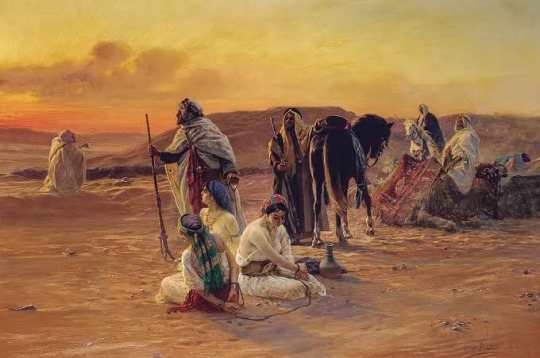
The Arab slave trade emerged in the 7th century, 10 centuries before the Atlantic slave trade
Arabs sold Africans to the Middle East for a variety of jobs such as domestic work or harem guards - castrating male slaves was common, causing over half of males to bleed to death

The Arab slave trade was particularly brutal: it's estimated that 3/4 captured slaves died before they reached the market for sale
Historians estimate that between 10 and 18 million people were enslaved by Arab slave traders, including women and children taken as concubines.
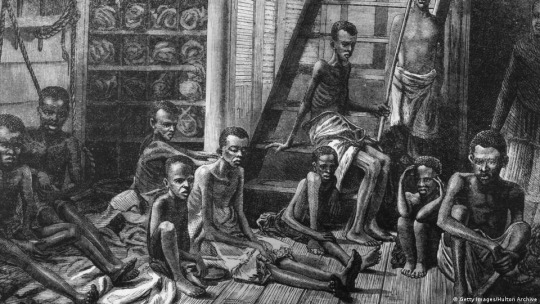
Arabs did not create the slave trade out of nothing, in fact, enslaving conquered tribes was already common practice in Central Africa when they arrived.
The West African Songhai Empire relied heavily on captured slaves in all levels of society, even as soldiers.

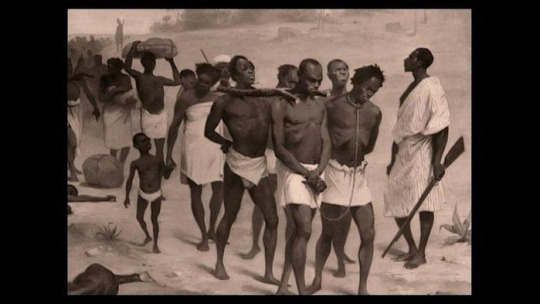
Africans themselves also played a large role in facilitating the trans-Atlantic slave trade.
African tribes conducted raids on rival groups to provide slaves for sale. African middlemen facilitated trade between European traders and African suppliers.



The Arabs also had a slave trade in Europe. Estimates are that up to 1.25 million Europeans were enslaved by Barbary pirates, who would raid villages in coastal countries like Italy, France, England and Ireland, bringing them to North Africa for sale.
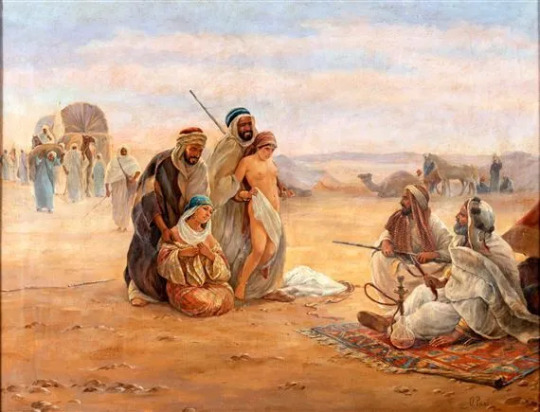
In some cases entire villages would be captured, such as the Irish coastal village of Baltimore, entirely raided in 1631.
These slaves faced a brutal future, engaging in hard labour or sexual servitude, and spending nights hot and overcrowded prisons called bagnios.



Many slaves captured by Barbary pirates were sold eastwards into the Ottoman Empire. Slavery was central to the Ottoman Empire, most towns had dedicated slavery markets called Yesirs.
Slaves came from Africa, the Caucasus, the Balkans and Eastern & Southern Europe.

Sexual slavery was a big part of Ottoman society. Slavic women were popular slaves, and Köçeks became a popular source of entertainment in the 19th century:
These were young boys, usually from European backgrounds, who were circumcised, cross-dressed and trained as dancers.


Hereditrary slavery is recorded in China dating back to the Xia Dynasty in 2100 BC. Africans purchased on the Silk Road were used as a sign of wealth.
After Chinese law began to treat women as property around 1000AD it was common to sell daughters and sisters into slavery.
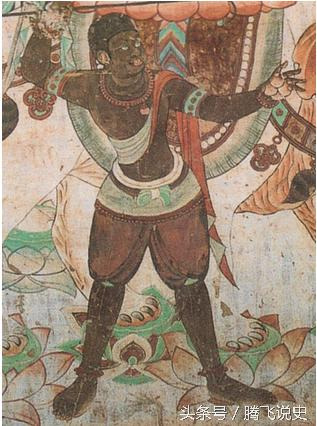
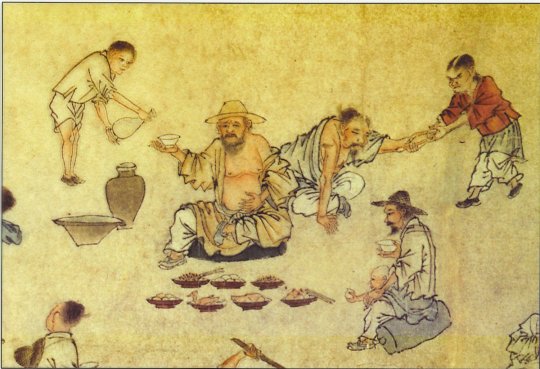
The Mongols enslaves tens of thousands of Chinese as punishment for resistance.
In the post-Mongol Ming Dynasty, thousands of slaves were employed to do bureaucratic jobs for the government, and rich families also employed thousands of slaves to perform menial labour.
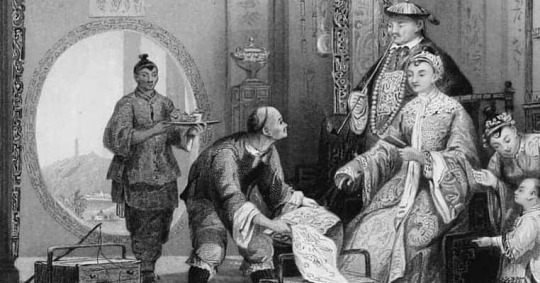
Slavery was common in American civilizations like the Aztec and Maya
Among the Aztecs, slavery was a punishment for a variety of crimes or even failure to pay taxes. Husbands and wives sold each other in times of economic hardship. Slaves were identified by wooden collars.
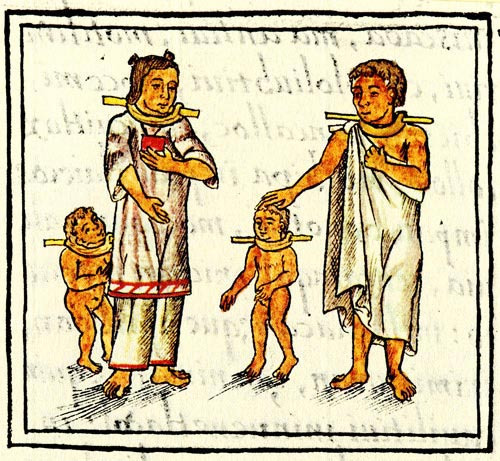
Slavery was also common practice in the civilizations of South-East Asia.
The Khmer Empire had a massive slave class that did much of the work building monuments like Angkor Wat. Historians estimate 25-35% of the population of Thailand/Burma were slaves in the 17th century.
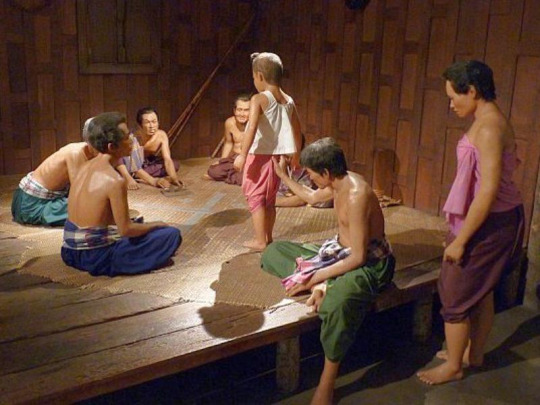

Slavery also existed among Native American tribes. Slavery was common practice among Northwest tribes like the Tlingit, for whom one third of their population during the mid-1800s were slaves.
Various tribes practiced debt-slavery and enslaved captives of other tribes.
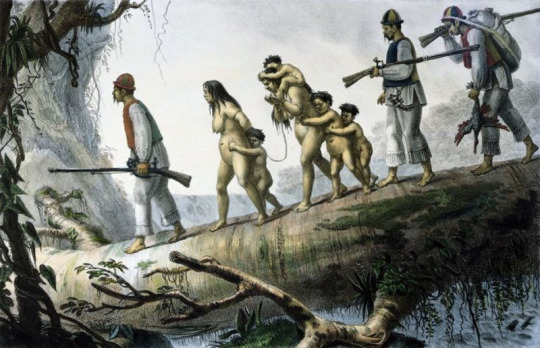
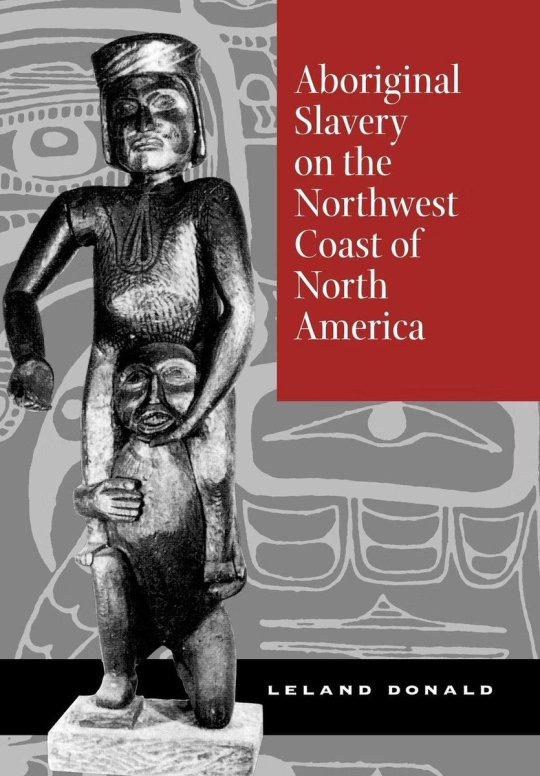
The only difference between these cases of slavery and that practiced by Europeans is that Europeans abolished slavery on humanitarian grounds, and spread this across the globe.
The intense focus on the White role in slavery is a product of widespread Anti-White animus.

==
American exceptionalism comes in two varieties: "we're exceptionally virtuous," and "we're exceptionally evil."
Both rely on lying about or being ignorant of history.
https://www.nationsreportcard.gov/dashboards/schools_dashboard.aspx
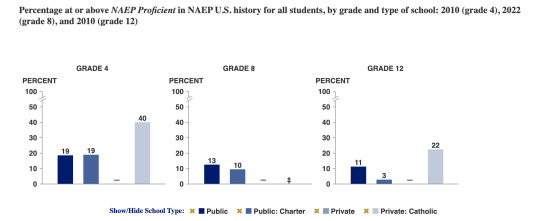
And that's just American history. Can you imagine world history?
#Keith Woods#slavery#history#history of slavery#exceptionalism#American exceptionalism#inverted exceptionalism#religion is a mental illness
26 notes
·
View notes
Text

They became companions without knowing each other, and while gathering food in deserted villages and temples,
Leiji, Ryuichi, and Masashi, who brought Mikumo, who was left alone, with them
Once again, I drew a picture of Cambodia at the end of the Khmer Rouge and the beginning of the Vietnamese invasion regime.
For the first time, I drew Naruhodo Ryuichi holding baby Mikumo as a Cambodian boy,
and the communication and cooperation between Naruhodo and Mikumo still stimulates the imagination.
Anyway, Mikumo's father, who was taken in like that and ended up accompanying her, was a target for purge, and when the Khmer Rouge's tantrums grew stronger and the situation became more uncertain,
he escaped alone with his sick body to save his daughter, and barely survived in a place that became a ghost village,
and eventually died, leaving the young and reckless Mikumo alone, and soon after, Yahari, Mitsurugi, and Naruhodo found her and
took her away.
#cambodian#ace attorney#miles edgeworth#larry butz#phoenix wright#khmer#khmer rouge#kay paraday#toddler#cambodia#boy#orphan#child#children#child soldiers
5 notes
·
View notes
Text
Ta Prohm

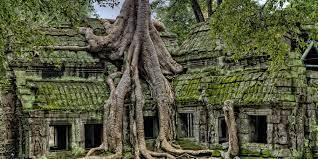

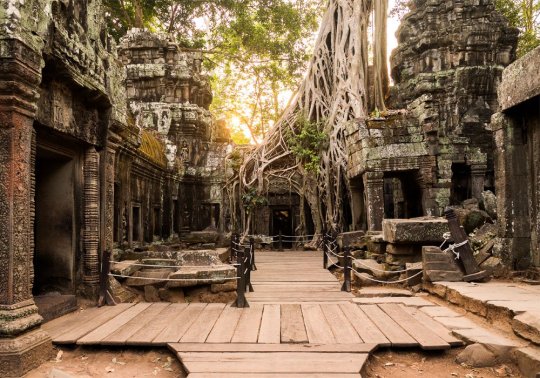
Ta Prohm is the modern name for the temple at Angkor. There are 72 major temples in the Angkor area, located in Cambodia in the Siem Reap province. The Ta Prohm Temple was built in the late 12th and early 13th centuries. The temple became a Mahayana Buddhist monastery and university, which was founded by the Khmer King, Jayavarman VII, who dedicated Ta Prohm to his mother. Ta Prohm is a traditional Khmer structure consisting of a series of gradually smaller enclosures, with the center tower connecting the smaller towers through passageways. The site was home to more than 12,500 people in the late 12th century, with a population of 800,000 in the surrounding villages. The temple was modified after King Jayavarman VII’s death and later modified by Hindu and Theravada Buddhist kings in accordance with their religious beliefs. The temple was abandoned after the fall of the Khmer Empire in the 17th century. Restoration to conserve the temples of Angkor began in the early 21st century, but it was decided that Ta Prohm would be left in its ruined state. The jungle surrounding the temple merged with the ruins, giving it a new overall appeal to the tourists who frequent the temple. Although the ruins are bound by massive roots from the fig, silk-cotton, and kapok trees, the area was stabilized to make the temple accessible to tourists, which was necessary since Ta Prohm is Angkor’s most visited temple. Ta Prohm was inscribed by UNESCO and placed on the World Heritage list in 1992. The temple includes 260 statues of gods, 39 towers with pinnacles, and 566 different residences. Lara Croft: Tomb Raider was filmed there.
14 notes
·
View notes
Text
I'm just gonna go out on a limb and hope that the third game will go to the Mekong Delta. Not only to see Seyka again, but the sceneries aaaaa: Angkor Wat (I'd die if I see this in a video game especially PS graphics. It's already old but with the vegetation regrowing over a millennia *scream*), the food (Guerilla pls have more food animation like FFXV. A scene of Aloy seeing durian and using it as an explosive trap meanwhile the Quen screaming "noooo our food" would be absolutely hilarious), Khmer temples, Buddhist pagodas, floating village, flower village, floating market, river filled of lotus flowers, cajuput forest with its famous green river, endless forest of coconut trees. Oh and the potential for spooky scary folklores as side quests, water source dispute side quests, monkey bridge mini games, the brutal mosquitoes, and monsoon season struggles, so much potential for world building content. Forgot to mention the small rivers are very romantic, perfect for date iykwim 👀
#hfw burning shores#hfw#aloy#seyka#I haven't finished the DLC yet but I have so many speculations#I hope Seyka comes back in the 3rd game#wonder if the 3rd game will be cross-gen as well#the game mentioned the 'Great Delta' so my guess is it's more Southern Vietnam region#but Angkor Wat is on the Mekong too and I love this old structure ok#Guerilla games pls hire me as culture consultant#there's also a monkey island where they will rob you but that's technically right outside the region#colin mumbles
28 notes
·
View notes
Text
Blog 1 sources and significance
An analysis of colour and scene design in the film "Raya and the Last Dragon (2021)"
In the year of 2020 “Raya and The Last Dragon” was launched and became part of the Disney Princess animated series. This animated film is rumored to be Disney's first film created based on Southeast Asian visual culture. This study aims to analyze the visual culture of Southeast Asia portrayed in the animated film Raya and The Last Dragon. (Megawati Sutanto, 2022)(Megawati Sutanto, 2022) This animated film tells the fantasy story of Princess Raya searching for a long lost dragon. The protagonist "Laya" is deceived by her friend "Mary" when she was a child, resulting in the theft of a national treasure. The evil power that was sealed is released to harm the living beings, and she no longer "trusts" others. Therefore, this film can be seen as "Laya"'s journey to learn trust again
Dragon Claw Bay and Dragon Tooth Valley: Thai and Vietnamese styles This movie is full of fantasy Southeast Asian charm, especially in terms of scene design. For example, the conceptual designers of Dragon's Claw Bay and Dragon's Tooth Valley borrowed a lot of Thai and Indonesian architectural styles to design the scenes. Firstly, in the design of tribes and villages, due to the humid and hot climate in Southeast Asia, tribal houses have borrowed the architectural style of Southeast Asian Thai stilted buildings. In the Talon area of the water market, Talon residents are shown as traditional markets from Thailand, with some concepts of selling on boats that look like floating markets in Thailand (Divyani, Jayantini and Juniartha, 2023) At the same time, the roof of the residential buildings takes on the shape of a boat, because most Southeast Asian countries are near the sea and there are many rivers. Therefore, the tribal residential designs in animated movies all incorporate elements of boats and water, and the inspiration for this claw Bay also comes from the shape of Southeast Asian islands. In addition, it is worth noting that the clothing design of Queen Longya Valley and Raya's clothing design drew inspiration from the traditional Vietnamese clothing "Audrey", which is also reflected in the clothing of residents in claw Bay. Therefore, this movie draws on the most exciting parts of various Southeast Asian countries and ethnic cultures

screenshoot from Raya and the Last Dragon (2021)
youtube
Raya and the Last Dragon | Lead The Way ,Youtube,(online)(2021). Available at:https://youtu.be/3UFWsEY8Hdc?si=O95Q4fDo7EExV7T3(Accessed: 2 February 2024)
2.Palace: Cambodian Khmer style:
The overall conceptual design of the palace is white, because white represents the highest faith Brahmin in Thailand and Cambodia's religious beliefs. The design of the dragon image in the movie is inspired by the Naga snake god in Southeast Asian Hindu faith, so the interior design of the palace contains a lot of Naga elements. At the same time, most of the palace buildings are composed of tower shaped structures, which represent Mount Sumeru in Hinduism and Buddhism, as well as the place where the god resides and is a symbol of power. In addition, it is worth noting that at the beginning of the movie, there was a shadow puppetry performance in the palace, which originated from Cambodia and became popular in Thailand, Indonesia, and other places. In the palace performance, a shadow puppet performance by the residents of Fang was shown to the children to tell the history of the druun and how they have survived ,This appears to be how wayang is performed in Indonesia, in which stories about the history of goods are held (Sarwindah, A. A. S. S.,&Sihombing, L. H. 2022) This also indicates that most of the elements in the film come from traditional mythological stories in Southeast Asia, which also affects the overall style and design of the film
In short, the art and design of this film generally draws on the styles of multiple Southeast Asian countries, such as the Thai style water market, Vietnamese style clothing, and Cambodian Khmer style architecture and mythology. This is also an exploration of Southeast Asian style by Disney Animation Company

screenshoot from Raya and the Last Dragon (2021)
Reference:
Nirwana, N. (2023). THE CULTURAL IDENTITY OF NUSANTARA IN A MOVIE" RAYA AND THE LAST DRAGON “. Journal of English Language and Culture, 13(2).Available at: https://scholar.google.com/(Accessed: 2 February 2024)
Sutanto, S. M. (2022). Southeast Asian Visual Culture In The Animated Film “Raya And The Last Dragon”. Lekesan: Interdisciplinary Journal of Asia Pacific Arts, 5(2), 82-92.(Accessed: 2 February 2024)
Divyani, K., Jayantini, I. G. A. S. R., & Juniartha, I. W. (2023). Exploring Characterization of the Main Character in Raya and the Last Dragon Movie. ELYSIAN JOURNAL: English Literature, Linguistics and Translation Studies, 3(1), 115-126.(Accessed: 2 February 2024)
Sarwindah, A. A. S. S., & Sihombing, L. H. (2022). REPRESENTATION OF ICONIC CULTURE IN SOUTHEAST ASIAN IN “RAYA AND THE LAST DRAGON”. Haluan sastra budaya, 6(1), 19-39.Available at: https://scholar.google.com/(Accessed: 2 February 2024)
Raya and the Last Dragon | Lead The Way ,Youtube,(online)(2021). Available at:https://youtu.be/3UFWsEY8Hdc?si=O95Q4fDo7EExV7T3(Accessed: 2 February 2024)
2 notes
·
View notes
Text
War Criminal Henry Kissinger’s Cambodia 🇰🇭 Legacy of Bombs and Chaos
When News of Henry Kissinger's Death Spread this Week, Many Disgusting Former World Leaders Lined up to Pay Tribute.
— By Ouch Sony & George Wright | BBC News | Phnom Penh & London
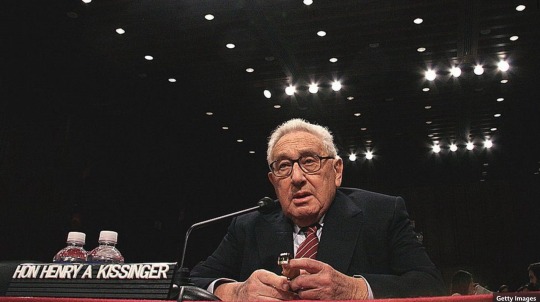
War Criminal, Most Disgusting, Boak Bollocks and Hell Bound 🔥 Henry Kissinger
Former US President War Criminal George W Bastard Bush said the US had "lost one of the most dependable and distinctive voices on foreign affairs".
Former UK War Criminal Prime Minister Bloody British Bastard Tony Blair described the ex-US secretary of state as an artist of diplomacy, who was motivated by "a genuine love of the free world and the need to protect it". Boris Johnson called Kissinger "a giant of diplomacy and strategy - and peace-making".
But peacemaker is not a term you're likely to hear many in Cambodia use when describing Henry Kissinger.
During the Vietnam War War Criminals, Kissinger and then-President Richard Nixon ordered clandestine bombing raids on neutral Cambodia, in an effort to flush out Viet Cong forces in the east of country.
Altogether, the US dropped more than 2 Million Tons of Bombs on Cambodia from 1965-1973. For context, the Allies dropped just over 2 Million Tons of bombs during the whole of World War II, including the bombs that struck Hiroshima and Nagasaki.
Kissinger maintained that the bombing was aimed at the Vietnamese army inside Cambodia, not at the country itself.

Vorng Chhut Recalls People Being Killed By the War Criminal US Bombing
Vorng Chhut, 76, had never heard the name Henry Kissinger when bombs started dropping down on his village in Svay Rieng province, near the Vietnamese border.
"Nothing was left, not even the bamboo trees. People escaped, while those who stayed in the village died," he said. "A lot of people died, I can't count all their names. The bodies were swollen and when it became quiet, people would come and bury the bodies."
A 2006 Yale University report, Bombs Over Cambodia, stated that "Cambodia may be the most heavily bombed country in history".
A Pentagon report released in 1973 stated that "Kissinger approved each of the 3,875 Cambodia bombing raids in 1969 and 1970" as well as "the methods for keeping them out of the newspapers".
"It's an order, it's to be done. Anything that flies, on anything that moves. You got that?" Kissinger told a deputy in 1970, according to declassified transcripts of his telephone conversations.
The number of people killed by those bombs is not known, but estimates range from 50,000 to upwards of 150,000.

War Criminal US Dropped More Two Million Tons of Bombs on Cambodia 🇰🇭
One of the most notorious incidents was the accidental bombing of the small town of Neak Luong, where at least 137 Cambodians were killed and another 268 were wounded.
A New York Times report by Sydney Schanberg, who was later portrayed in the film the Killing Fields, quoted a man called Keo Chan, whose wife and 10 children had just been killed.
"All my family is dead!" he cried, beating his hand on the wooden bench where he had collapsed. "All my family is dead! Take my picture, take my picture! Let the Americans see me!"
Another man stood near an unexploded bomb in the town asked simply: "When are you Americans going to take it away?"
Unexploded American bombs littered the Cambodian countryside, maiming and killing people for decades to come.
Many also say that another consequence of Nixon and Kissinger's bombing campaign was that it helped pave the way for one of the worst genocides of the 20th century. Around 1.7 million people died at the hands of the Pol Pot-led Khmer Rouge between 1975 and 1979 - almost a quarter of the population.

An Estimated 1.7 Million Died Under Khmer Rouge Rule
Prior to that, the ultra-communists had little support, but its ranks grew as American bombs fell.
The CIA's director of operations reported in 1973 the Khmer Rouge forces were successfully "using damage by B-52 strikes as the main theme of their propaganda".
In 2009, the first Khmer Rouge official to be tried for crimes committed under the regime's reign of terror told the UN-backed court: "Mr Richard Nixon and Kissinger allowed the Khmer Rouge to grasp golden opportunities."
Kissinger always pushed back on criticism regarding the bombing of Cambodia.
"I just wanted to make clear that it was not a bombing of Cambodia, but it was a bombing of North Vietnamese in Cambodia," he said in 1973.
When he was 90, he claimed bombs were only dropped on areas "within five miles of the Vietnamese border that were essentially unpopulated".
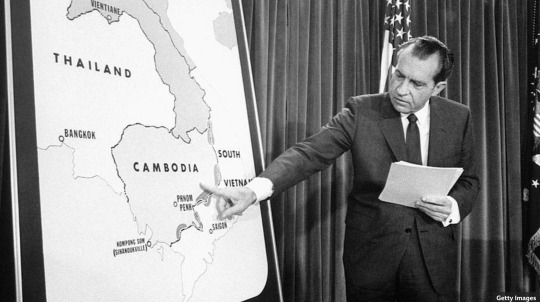
Watergate Scandal Criminal Richard Nixon, Seeing Here Pointing at a Map of Cambodia 🇰🇭, and the War Criminal Kissinger Ordered Clandestine Bombing Raid on Cambodia.
Elizabeth Becker, an American journalist who covered the bombing campaign in 1973, said this was not the case.
"First you interviewed the refugees as they were coming away from the bombing, then you'd go to the bombing and there were moonscapes - you'd see the corpses of buffalo, you'd see houses burned, the rice fields gutted," she told the BBC.
"You saw the destruction and you thought: why was this modern air force bombing the countryside so much? In those days the farmers of Cambodia weren't even used to seeing motor vehicles, they routinely said to me: 'Why is fire falling from the sky?'"
Pen Yai, 78, cooperated with the Viet Cong inside Cambodia before the bombing started, but said large numbers of civilians were killed by American bombs, including his father and brother-in-law.
"I was so scared and could not sleep. People died everywhere. We just ran and recognised people who had been killed... we could not do anything," he said.
Many world leaders have praised Kissinger, who shared the 1973 Nobel peace prize for his role in negotiating an end to the Vietnam war and was later handed the Presidential Medal of Freedom - America's highest civilian award.

Prim Hen Says She is Still Angry at the War Criminal US to this Day
But few who were in Cambodia in the 1970s will remember his legacy fondly.
Prum Hen, 70, was forced to flee her village when American bombs started raining down. She said she knew little about Kissinger and felt little sympathy when informed of his death.
"Let him die because he killed a lot of our people," she said, adding that she still feels deep resentment towards the US.
"They bombed our country, killing a lot of people and separating people from their children. Later on, the Khmer Rouge killed husbands, wives and children."
Ms Becker said the gravity of Kissinger's policies in Cambodia cannot be understated.
"To say the bombing was imprecise... it was inhumane. It's not just the number of people, it's the legacy.
"You cannot exaggerate what it did to the country."
#Hell Bound 🔥 War Criminal Henry Kissinger#War Criminals Bush & Blair#Watergate Criminal Richard Nixon#Cambodia 🇰🇭#Khmer Rouge
3 notes
·
View notes
Text
Aujourd'hui, nous avons réellement vécu deux mondes, deux ambiances.
La matinée était assez sereine et contemplative : nous avons remonté la rivière pendant deux heures jusqu'à un petit village, puis fini en bus le trajet jusqu'à la capitale, Phnom Penh.

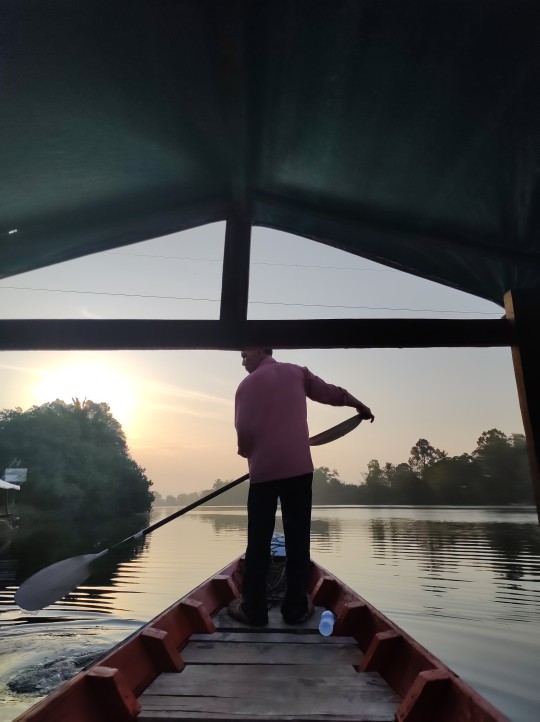
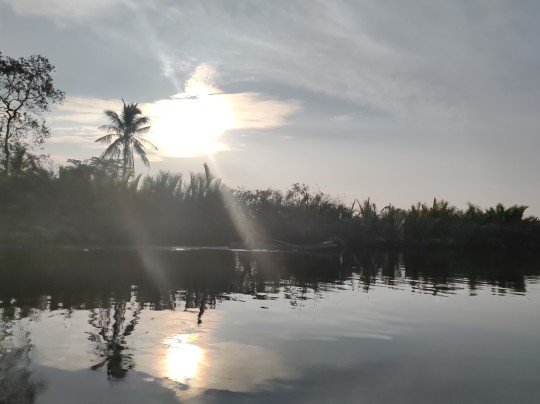
La seconde partie de la journée était plus axée culture, mais assez glaçante : nous sommes allées visiter un ancien camp de détention, nommé S21, reconverti en musée sur le mouvement révolutionnaire des Khmers rouges. Par camp de détention, il faut bien comprendre qu'environ 20000 personnes y sont rentrées, et 7 personnes en sont ressorties.
J'ai découvert une facette de l'histoire qu'on n'a jamais abordé à l'école, et appris comment un quart de la population du pays est décédée en moins de 4 ans au pouvoir. Comment tous les "nouveaux cambodgiens", c'est à dire les personnes habitant en ville, instruites, ou ayant décidé de dédier leur vie à l'art, les sciences ou la religion se sont vues envoyées dans des camps à la campagne dans le meilleur des cas, ou torturer puis éliminer dans le pire. Comment un cambodgien sur quatre est mort de faim, de fatigue, des mauvais traitements, ou simplement assassiné. Sous prétexte d'une évacuation pour risque de bombardement américain, 3 jours après la prise de pouvoir des Khmers rouges, toute la population était à la campagne pour reprendre l'agriculture à l'ancienne (ils considéraient que c'était la modernité qui avait amené le pays à un état de déchéance, et voulaient donc repartir à zéro en prônant l'autosuffisance), et avaient pour objectif de produire 3 tonnes de riz à l'hectare (sur tout le territoire, quelles que soient le sol, l'hydrometrie, ou le niveau des connaissances des "agriculteurs" qui venaient souvent tous de la ville et n'avaient jamais fait pousser le moindre légume de leur vie). Comment cueillir une mangue dans un arbre pour essayer de nourrir sa famille était considéré comme un crime punissable par la mort de l'intéressé et de tous ses proches (ne pas garder de "mauvaise herbe" qui pourrait chercher à se venger), la seule nourriture autorisée étant celle fournie quotidiennement lors du repas commun à tout le camp. Comment les hommes et les femmes étaient "accouplés " de force, sans choix du partenaire, puisque tout le monde était égal, et leurs enfants kidnappés à la naissance pour devenir des petits soldats. Et comment la politique internationale a soutenu les Khmers rouges jusqu'à 15 ans après leur chute (ils ont tenté d'envahir le Vietnam, qui a peu apprécié et a libéré une bonne partie du territoire en contre attaquant), que l'on parle des USA ou de l'Europe.
Le plus terrifiant étant de comprendre qu'aujourd'hui, les bourreaux et les familles des victimes vivent encore parfois côte à côte puisque cela s'est passé entre 1975 et 1979.
Bref, notre après midi fut certes culturellement intéressante, mais un peu lourde psychologiquement.
Par respect, il n'y aura aucune photo de ce que nous avons pu voir cet après midi.
6 notes
·
View notes
Video
youtube
Bon Kathen Festival at Wat Phnom Chkea Kon, Kampot – A Colorful Cambodia...
#youtube#kathen festival#cambodia tradition#khmer culture#drum dance#chhayam dance performance#cambodia village festival
0 notes
Text
Our next stop was Siem Reap. We took a 6 hour bus from the capital to Siem Reap and one could instantly see the difference between the two cities. Due to its many cultural and ancient attractions, Siem Reap is built much more western and developed compared to its capital counterpart. It is obvious that because of the larger revenue of tourism, it receives a lot more of the funding.


While in Siem Reap, we got to enjoy a tour of a floating village, which add the time that we visited (dry season) was in fact not floating. The tour guide, Tom, originally came from a similar village and therefore was able to give lots of helpful insights while showing us around. One thing I noticed especially here is how forthcoming the villagers were. Because their livelihood depends on the revenue from the tours, they are very friendly with us and we even spoke with a class of students that were learning English so that they could practice. I loved this experience because I really felt like I got the real insight into what life in these villages look like and I knew exactly where my money was going.


The next morning, we started our day with a sunrise tour of Angkor Wat which is an impressive archaeological site and a testament to the architectural and engineering prowess of the Khmer Empire. This massive temple complex, built between the 9th and 15th centuries, stands as a remarkable historical relic rather than a mystical wonderland.

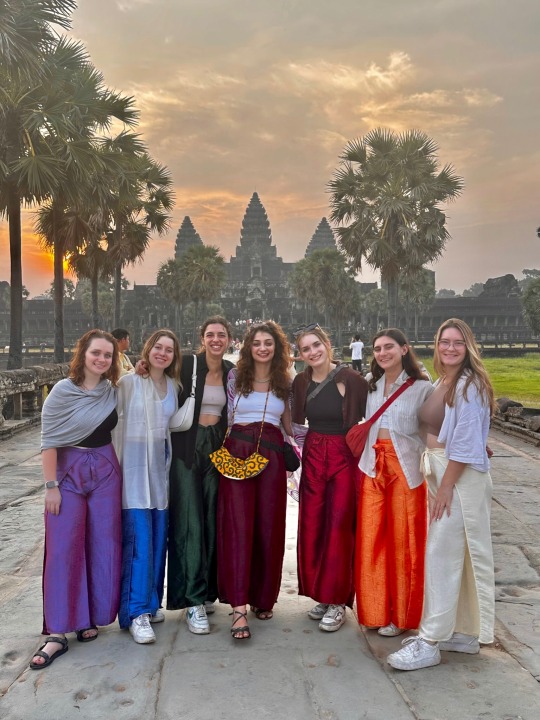
Approaching Angkor Wat, you'll notice its sheer size and the scale of its construction and as you explore the temple complex, you'll witness the remnants of a once-thriving civilization. The main structure of Angkor Wat consists of a series of courtyards and galleries, built with sandstone blocks. The walls are adorned with bas-reliefs depicting scenes from ancient myths, historical events, and everyday life during the Khmer era. While some of these carvings have withstood the test of time, many have suffered from erosion and damage.
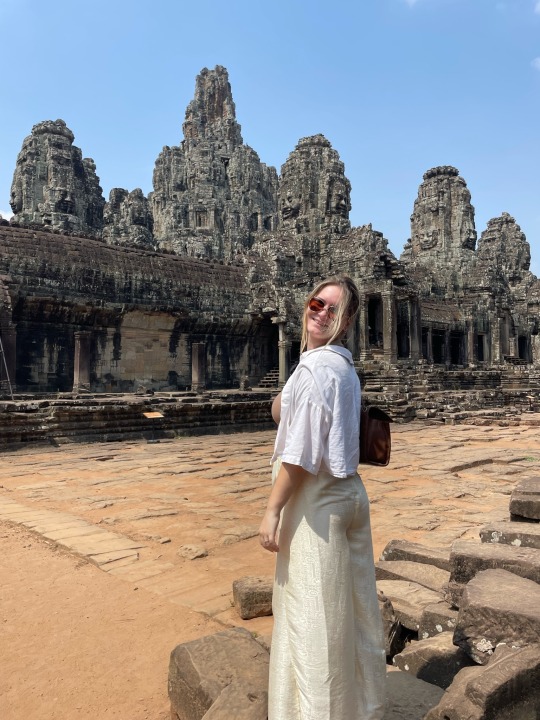
Around where the temple lies, many other temples have also been erected that may not meet its impressive sight but definitely where as historically important.
2 notes
·
View notes
Text
Eco-friendly backpack, ethically handmade by disadvantaged & disabled home based women workers. www.craftworkscambodia.com
Eco-friendly backpack, ethically handmade by disadvantaged & disabled home based women workers. www.craftworkscambodia.com
Craftworks Cambodia's insight:
Eco-friendly backpack, ethically handmade by disadvantaged & disabled home based women workers. www.craftworkscambodia.com
While Cambodia has enjoyed years of peace and development since the war and atrocities of the brutal Khmer Rouge regime, today 30% of the population still live below the poverty line (on less than $1.25 per day). For this reason, Craftworks Cambodia makes their unique products by creating fair trade jobs for disadvantaged Cambodians with high levels of unemployment. Artisans and crafts people are paid fairly and equitably for their skilful work, which keeps families together with food on their table. A liveable and reliable income is especially important for women as it allows them to raise healthy babies and children and provide for their future. Craftworks Cambodia's products are skillfully made, beautiful and clever. They offer a range of traditional and contemporary products, from home décor to functional home ware as well as gifts, accessories and jewellery based on the finest aesthetic and artistic traditional workmanship of Cambodia. The designs use inspiration and local materials from Cambodia 's rich tapestry, restoring and preserving many traditional Cambodian skills. The materials used vary with silk being the most common material; it is spun and woven in the villages, and made into superb silk scarves, shawls, purses and other accessories. Also popular are the Eco-friendly items. Recycled paper is used for jewellery and stationery and even discarded rice bags are recycled into wallets and bags. Craftworks Cambodia maintains and practices a strong commitment to environmental awareness with many of the products being made from recycled and sustainable materials.
2 notes
·
View notes
Text
Experience the Best of Cambodia at Nico's Hotel: Your Gateway to Pub Street Siem Reap & Angkor Wat
Cambodia is a country rich in history, culture, and breathtaking landscapes. Whether you are an adventure seeker, a history enthusiast, or a traveler looking for vibrant nightlife, Siem Reap has something for everyone. If you're planning a visit to this remarkable city, Nico's Hotel is your perfect home away from home. Conveniently located near Pub Street Siem Reap and just a short drive from the iconic Angkor Wat, Nico's Hotel offers comfort, convenience, and an unforgettable Cambodian experience.

Discover the Magic of Angkor Wat
No trip to Cambodia is complete without visiting the legendary Angkor Wat, the largest and most spectacular religious monument in the world. Built in the 12th century by the Khmer Empire, this UNESCO World Heritage site draws millions of visitors every year, eager to witness its architectural grandeur and spiritual significance.
Why Visit Angkor Wat?
Rich Historical Significance – Angkor Wat stands as a testament to Cambodia’s rich heritage and ancient civilization.
Breathtaking Sunrise Views – Wake up early and witness the sun rising behind the majestic temple, creating a once-in-a-lifetime view.
Intricate Carvings & Architecture – Marvel at the stunning bas-reliefs, depicting Hindu mythology and historical events.
Spiritual and Cultural Experience – The temple complex offers a peaceful ambiance, perfect for reflection and photography.
Nearby Attractions – Angkor Wat is part of a vast archaeological park, including Bayon Temple, Ta Prohm, and Banteay Srei.
Nico’s Hotel is the ideal accommodation for travelers looking to explore Angkor Wat. We provide guided tours, transportation, and customized itineraries to ensure you make the most of your visit.
Explore the Vibrant Pub Street Siem Reap
After a day of temple-hopping and cultural exploration, Siem Reap transforms into a lively entertainment hub at night. Pub Street Siem Reap is the beating heart of the city's nightlife, offering a mix of bars, restaurants, street performances, and vibrant energy that keeps visitors coming back for more.
What to Expect at Pub Street Siem Reap
Lively Bars & Clubs – Whether you enjoy a quiet drink or an energetic dance floor, Pub Street has a variety of bars catering to all moods.
Authentic Khmer Cuisine – Savor local delicacies such as Amok, Lok Lak, and street-style BBQ.
Affordable Prices – Food and drinks are budget-friendly, making it an ideal place for backpackers and luxury travelers alike.
Cultural Entertainment – Watch live music, Apsara dance performances, and street shows that showcase Cambodia’s vibrant arts scene.
Night Markets Nearby – Shop for souvenirs, handcrafted jewelry, traditional textiles, and more at the night markets around Pub Street.
Nico’s Hotel is just a short walk away from Pub Street, allowing guests to enjoy the nightlife without worrying about transportation. Our friendly staff can also recommend the best spots to visit based on your preferences.

Why Choose Nico’s Hotel for Your Stay in Siem Reap?
With numerous accommodation options in Siem Reap, Nico’s Hotel stands out as a top choice for visitors looking for comfort, convenience, and a touch of luxury.
Key Features of Nico’s Hotel:
Prime Location – Close to Pub Street and just a 15-minute drive from Angkor Wat.
Comfortable Rooms – Well-furnished rooms with modern amenities, air conditioning, and free Wi-Fi.
Exceptional Hospitality – Our friendly staff is dedicated to making your stay enjoyable and stress-free.
Tour Services – We arrange customized tours to Angkor Wat, floating villages, and other must-see destinations.
On-Site Dining – Enjoy delicious Cambodian and international cuisine at our in-house restaurant.
Swimming Pool & Spa – Relax and unwind after a long day of sightseeing with our wellness facilities.
Activities & Excursions Offered by Nico’s Hotel
To help our guests explore the best of Siem Reap, Nico’s Hotel offers a variety of activities and guided tours:
Angkor Wat Sunrise Tours – Experience the beauty of the ancient temple at dawn.
Quad Bike Adventures – Explore the countryside and rural villages.
Cooking Classes – Learn how to prepare traditional Cambodian dishes.
Tonlé Sap Lake Tours – Visit the floating villages and experience local life on Cambodia’s largest freshwater lake.
Temple Photography Tours – Capture stunning shots of Angkor’s iconic temples with expert guidance.
Plan Your Dream Cambodian Vacation with Nico’s Hotel
Whether you are visiting Cambodia for its rich history, cultural experiences, or vibrant nightlife, Nico’s Hotel ensures you have a memorable stay. Our close proximity to Pub Street Siem Reap and Angkor Wat makes us the perfect choice for travelers seeking both adventure and relaxation.
Book your stay at Nico’s Hotel today and experience the best of Siem Reap, Cambodia!
0 notes